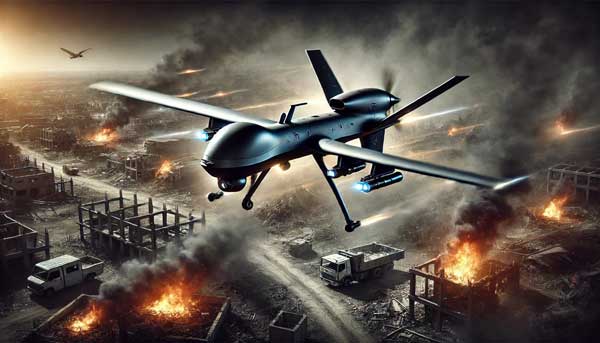Drones redefine warfare with persistent and expanding precision strikes in Ukraine conflict

[Drone used in a war. Credit to: OpenAI, DALL·E]
The recent surge in drone attacks during the Ukraine conflict underscores their growing significance in modern warfare.
A January 4 drone strike in Donetsk killed a Russian journalist, followed by a larger-scale January 8 attack targeting critical infrastructure in Saratov, exemplifying the expanding reliance on UAVs for both tactical and strategic operations.
In the early hours of January 4, a Ukrainian drone struck a vehicle carrying Russian journalists in Donetsk, killing freelance journalist Alexander Martemyanov and injuring five others.
Survivors, including Maksim Romanenko, described the attack as entirely unexpected, reflecting the evolving nature of UAV strikes—both sudden and lethal.
Unlike traditional warfare, these strikes often occur far from the front lines, as demonstrated by this incident, which marked a significant escalation in both the precision and range of drone capabilities.
The attack was characterized as a "kamikaze" drone strike due to its single-use nature and deliberate targeting of specific individuals.
Its occurrence far from active battle zones emphasizes the increasing advancement of drone technology, enabling long-range, high-impact strikes with minimal human intervention.
Historically employed primarily for reconnaissance, drones have now transitioned into a dual role, seamlessly combining surveillance with precise offensive capabilities.
Their ability to penetrate deep into enemy territory without risking personnel has redefined the parameters of engagement in modern warfare.
Just days later, on January 8, Ukraine launched a large-scale drone strike on industrial facilities in Russia's Saratov region near the Volga River.
The strike ignited a fire at an industrial plant and appeared to target another facility supplying fuel to the Engels-2 airbase, home to some of Russia's strategic bombers.
Although Russian authorities reported no casualties, the strike underscored the increasing strategic importance of drones in disrupting logistical networks and military operations.
Ukrainian forces stressed the attack's success in damaging critical infrastructure, demonstrating the tactical and strategic value UAVs bring to modern conflict.
The Russian Ministry of Defense reported intercepting 32 drones during the Saratov attack, with 11 destroyed over the region itself.
The Saratov incident, much like the Donetsk strike, serves as a stark reminder of how drones are reshaping the dynamics of conflict, shifting the balance of power, and challenging conventional military paradigms.
For Ukraine, UAVs represent a cost-effective countermeasure to Russia's superior military resources.
By deploying drones, Ukrainian forces can conduct operations that disrupt supply chains, damage infrastructure, and weaken the enemy’s strategic position—all while minimizing risks to their own personnel.
Conversely, these attacks have revealed critical vulnerabilities in Russia’s defense systems and infrastructure, underscoring the need for reevaluating how to mitigate such threats moving forward.
However, with drones now central to military operations, their growing prominence has sparked debates about their ethical and strategic implications.
While UAVs offer high-impact solutions for nations with limited resources, their increasing use raises concerns about the risks of automated warfare, including the risks of misuse and escalation.
The Ukraine conflict has exposed both the opportunities and challenges associated with drone technology, providing a glimpse into the future of warfare.
From precision targeting of individual vehicles to disrupting critical supply lines, drones are reshaping the battlefield in unprecedented ways.
The attacks in Donetsk and Saratov exemplify this shift, demonstrating the stealth and power of UAVs in modern military strategy.
As the conflict progresses, drones are not only influencing the course of the war but also signaling broader shifts in how wars are waged and won.

- David Minjae Ko / Grade 12
- Seoul Science High School

![THE HERALD STUDENT REPORTERS [US]](/assets/images/logo_student_us.png)
![THE HERALD STUDENT REPORTERS [Canada]](/assets/images/logo_student_ca.png)
